The series-production counterpart is set to follow in late 2020. Initial deliveries will be made to customers in early 2021.
It's the next electric Audi after the e-tron SUV and the e‑tron Sportback slated for 2019.
The concept car shows a flat-floor architecture that provides for Gran Turismo proportions and a low centre of gravity. It will have 434kW/590PS ensure performance fit for a sports car.
The torque is transferred to the wheels via the quattro permanent all-wheel drive with torque vectoring.
The performance subsidiary Audi Sport GmbH is charged with subsequently transforming the car into a series-production model.
GT sizing
The Audi e‑tron GT concept has the proportions of a classic Gran Turismo - flat, wide and with a long wheelbase. It is 4.96-metre long, 1.96-metre wide and 1.38‑metre high.
The lightweight body of the four-door coupé is made using various materials. The roof is made from carbon along with numerous aluminium components and supporting elements made from high-strength steel.
The technology for this automobile was developed in collaboration with Porsche. The gently sloping roofline of the e-tron GT concept that extends well into the rear echoes the Sportback layout that is the hallmark of the brand.
The cabin that tapers strongly towards the rear stands out compared with current Audi models. Wheel arches and shoulders are sculpted emphatically and, together with the flat floor that is unusual for an electric vehicle, visually underlines the low centre of gravity and the dynamic potential of the e-tron GT concept.

The broad lines and the numerous functional elements of the body as well as the air vents of the wheel arches and the solid rear diffuser emphasise its origins in the wind tunnel. A low drag coefficient that reduces fuel consumption and the low uplift visually characterise the design.
The sill area between the wheel arches has been drawn way outwards, creating a distinctive contrast with the cabin.
The sill draws the eye to the underfloor area where the battery and thus the energy centre of the e-tron GT concept are located.
The design of the wheels with their five twin spokes is also visibly aligned to their function. Their dynamic design provides optimum ventilation of the brake discs while also reducing drag. Shod with 285/30 size tyres, the 22-inch wheels also make a clear statement when seen from the side.
The hallmark Audi Singleframe is located in the centre of the front section. Compared with the two e-tron SUVs its architecture is much more horizontal. The top half comes with a cover painted in body colour. Its surface structure is reminiscent of the typical honeycomb pattern of the grille on the Audi RS models – a visual signal which characterises the Audi e-tron GT concept as a future product of Audi Sport GmbH.
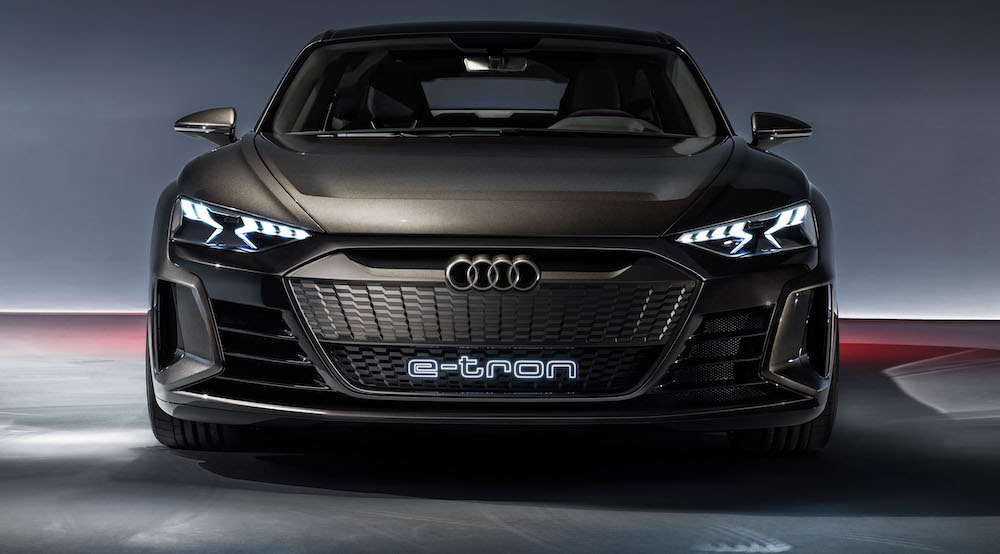
Together with the targeted airflow of the body, large air inlets in the front effectively cool the assemblies, battery and brakes. The hood with its airflow on the surface echoes the brand’s two latest show cars, the Aicon and the PB18 e-tron. It is designed in such a way that the airflow hugs the body, thus reducing undesired swirl.
The arrow-shaped front section also emphasises the matrix LED headlights with laser high beam, underscoring the dynamic presence of the e-tron GT concept even while stationary.
As already seen with the brand’s current Visions vehicles, the light is also animated here and welcomes the driver with a short function sequence, the wave of light that extends horizontally: a new visual signature that is set to find its way into series production in future.
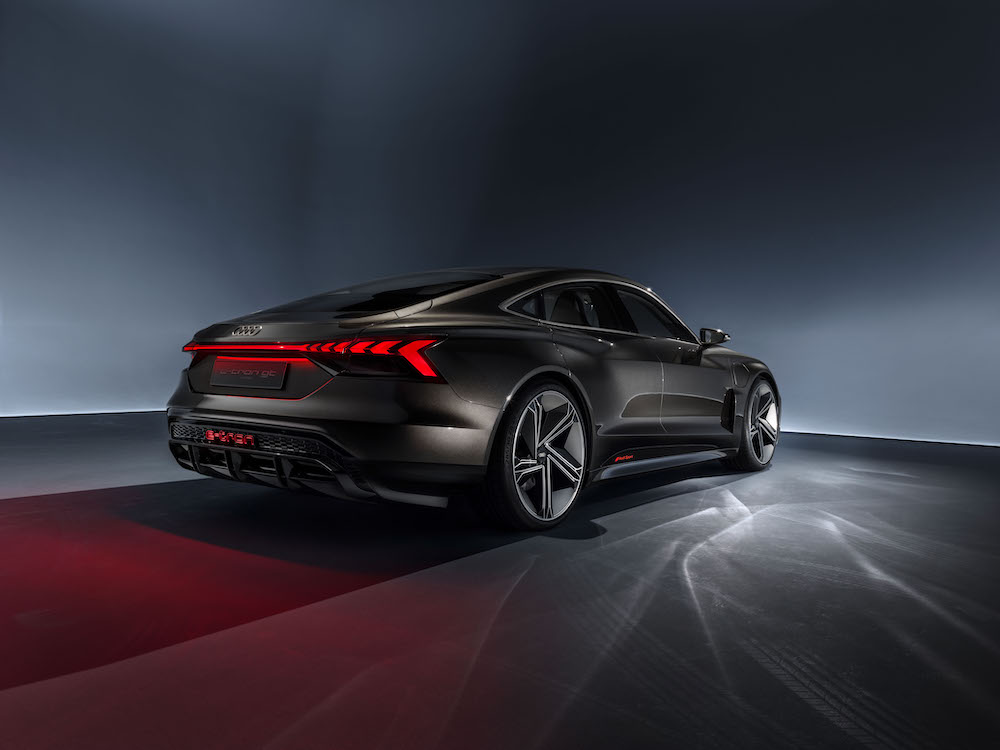
A light strip runs across the entire width of the rear. This strip dissipates at the outer edges, in the actual lighting units, into individual wedge-shaped LED segments. This architecture links the e-tron GT with the series-production SUV e-tron, making both instantly recognisable even in the dark as Audi electric automobiles.
The new exterior colour kinetic dust is a warm, dark colour akin to titanium. Depending on the incidence and movement of the light, it provides significant contrast between the body surfaces. Matt, warm-tinted aluminium elements on the window slot trim and rims emphasise these effects even further.
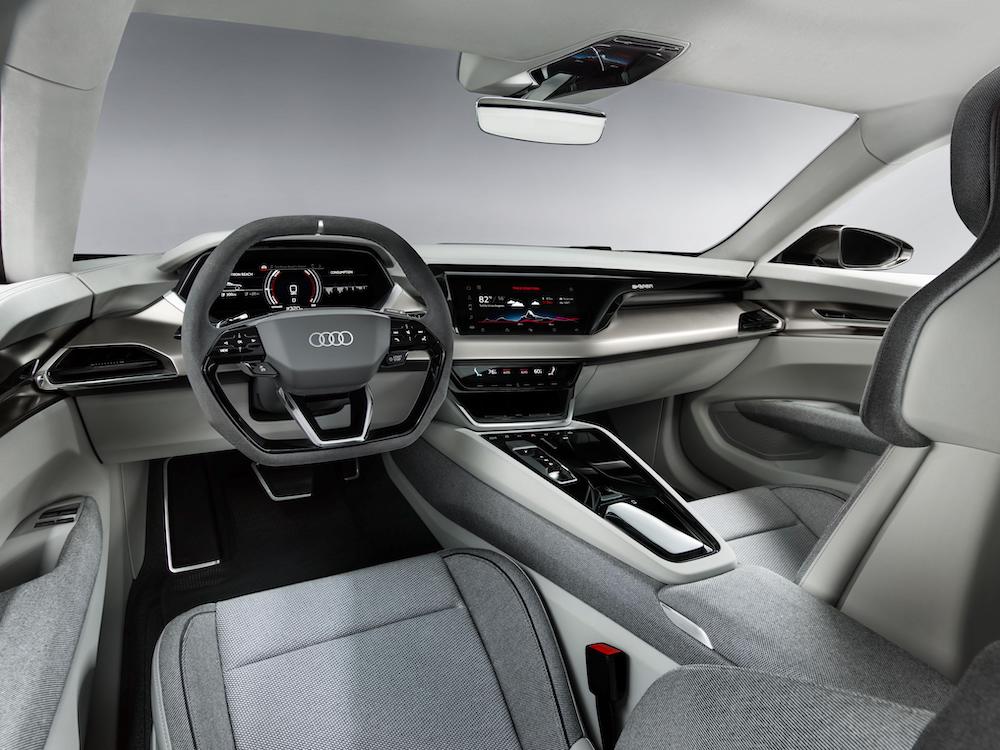
Vegan interior
Four doors, four seats with 2.90 metres wheelbase – in the interior the e‑tron GT concept provides a large dose of everyday usability, coupled with a high quality feel.
The functional centre of the interior is located at the front left, visibly focused on the driver’s seat. The centre console, the large touchscreen in the top section and the line from the door rail and cockpit frame the driver’s workplace, perfectly incorporate the driver ergonomically with the controls and the infotainment of the Audi e‑tron GT.
Light colours in the top section of the cockpit and the gradually darker gradation through to the floor area create the impression of clear width. Sport seats inspired by motor racing in both rows of seats provide optimum lateral support even while cornering at speed.
Both the screen of the central instrument and the touchscreen above the centre console come with a black-panel look finish.
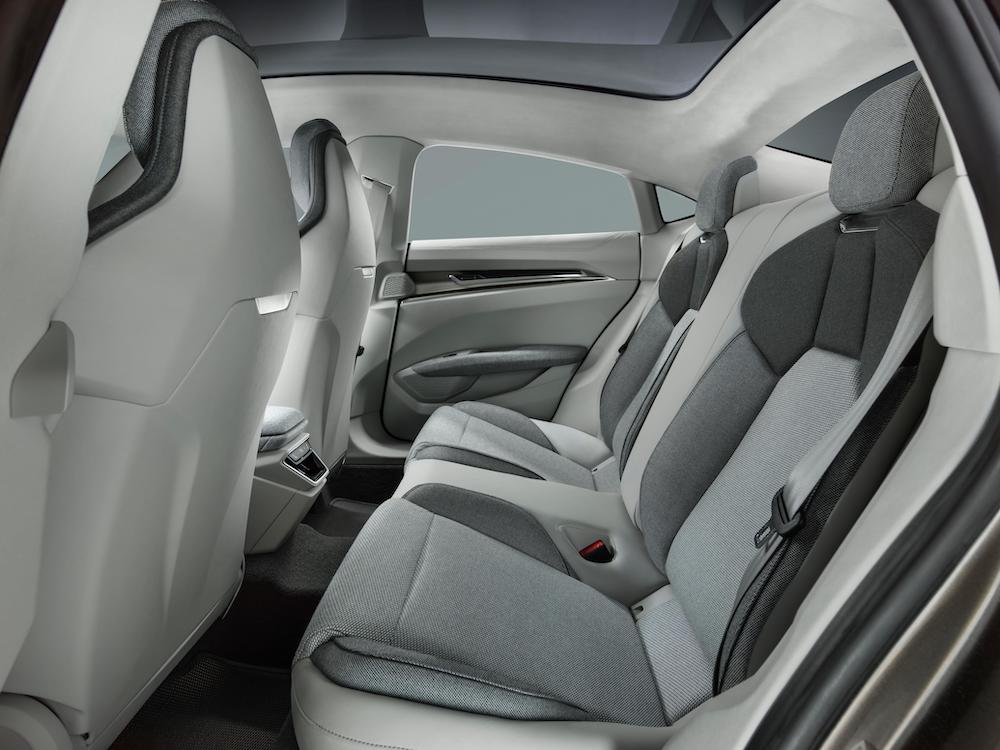
Various layouts are available for the monitors to present the functions depending on the driver’s preference, including virtual instrument dials, easy-to-read navigation maps with information on the range, or various infotainment function menus. They are controlled via the touchscreen with tactile feedback.
With the concept car the designers have gone for the consistent use of sustainable materials. Animal-based products are not used : the Audi e‑tron GT concept comes with a vegan interior.
Synthetic leather is used on the seats and other trim surfaces. Fabrics made from recycled fibres are used on the seat cushions as well as the armrests and on the centre console.

Microfibre material adorns the headlining and the trim of the window pillars. Even the deep-pile floor carpet is made from sustainable Econyl yarn, a recycled fibre made from used fishing nets.
With two luggage compartments, the e-tron GT concept offers a great many options for a Gran Turismo. Here it makes full use of its concept advantage as an electric automobile with compact drive units. The rear with its large tailgate offers up to 450 litres of luggage capacity. Under the bonnet there is an extra 100 litres of capacity.
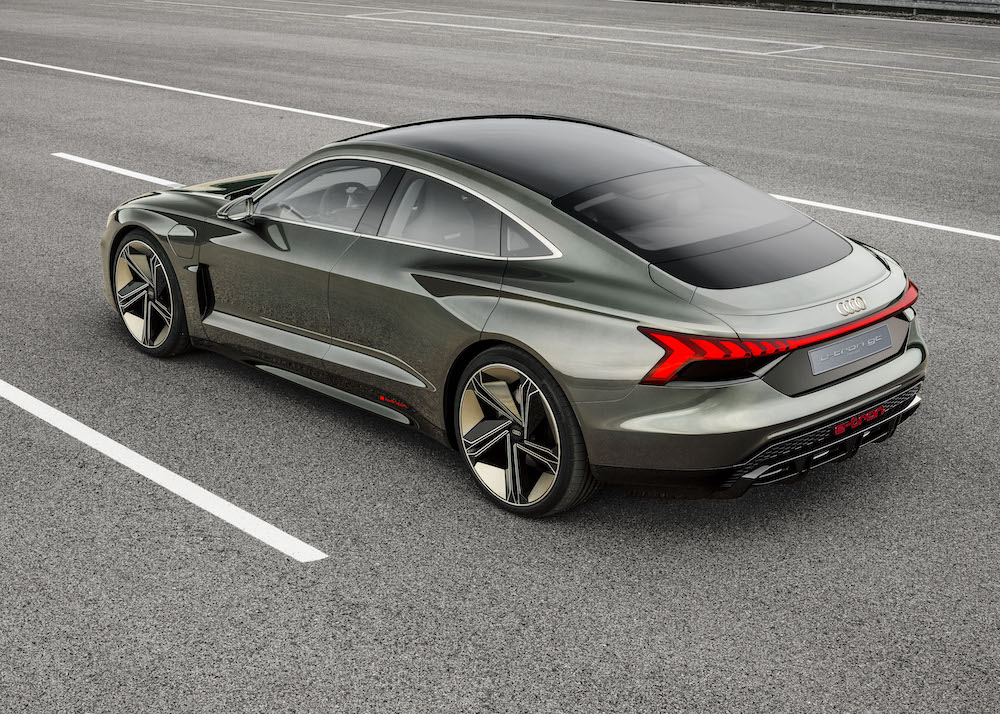
Performance and range
The all-electric drive musters 434kW/590hp of system power. Separate electric motors are fitted to the front and rear axles. In both cases these are permanently excited synchronous motors. This is an electric quattro since there is no mechanical link between the front and rear axle. The electronic control system coordinates the drive between the axles as well as between left and right wheels. That means optimum traction and just the desired amount of slip.
In future, the vehicle should accelerate from 0 to 100kph in around 3.5 seconds before going on to 200kph in just over 12 seconds. The top speed is regulated at 240kph to maximise the range.

One feature that not all the competition can match is the option of fully using the drive’s acceleration potential several times in succession. While elsewhere the drive is switched to overdrive for thermal considerations, the e-tron GT concept can provide the driver with the full potential of both motors and the battery thanks to its sophisticated cooling strategy.
The range of the concept car will be over 400km, determined according to the new WLTP standard. The required drive energy comes from a lithium-ion battery with an energy content of more than 90 kWh, which takes up the entire underfloor area between the front and rear axle with its flat design.
The advantage of this design is the car’s extremely low centre of gravity – comparable with that of the Audi R8 – which in turn decisively benefits dynamic handling.
The recuperation system increases the range by up to 30 percent on Audi electric vehicles – this is essential even with a sports car such as the e-tron GT concept. The recuperation involves both the two electric motors and the electro-hydraulically integrated brake control system.
The e-tron GT concept features ceramic discs.

Three ways to charge
The battery can be charged in several ways: using a cable which is connected behind the flap in the left front wing, or by means of contactless induction with Audi Wireless Charging. Here a charging pad with integral coil is installed permanently on the floor where the car is to be parked, and connected to the power supply.
The alternating magnetic field induces an alternating voltage in the secondary coil fitted in the floor of the car, across the air gap. With a charging output of 11 kW the Audi e-tron GT concept can be fully charged conveniently overnight.
Wired charging is much faster as the four-door coupé is fitted with an 800-volt system. This substantially reduces charging times compared with conventional systems that are currently in use.

Thus it takes around 20 minutes to recharge the battery to 80 percent of its capacity, once again providing a range of more than 318km (WLTP). The e-tron GT concept can, however, also be recharged at charging points with lower voltages, providing the driver with access to the entire charging network.
Audi launched its electric offensive with the world premiere of the e-tron in September 2018. By 2025, it will offer 12 cars with all-electric drive in the most important markets worldwide and achieve roughly one-third of its sales with electrified models.
The range will cover every relevant market segment from the compact to the full-size class. In addition, there will be a range of models with classic body layouts such as Avant and Sportback.
Another joint project of the development departments at Audi and Porsche is the Premium Platform Electric (PPE). It will be the foundation for multiple Audi model families with all-electric drive covering the high-volume B through D segments.










